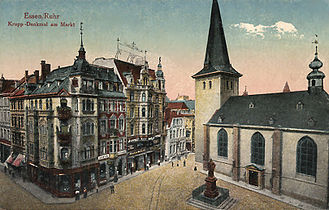Market Church (Essen)
The Essen market church , which was Gertrudiskirche until the end of the 19th century , is located in downtown Essen on the market, the original market square in Essen, which was once the economic, political and religious center of the city. The originally Romanesque , after partial reconstruction, late Gothic hall church was the first Protestant church in Essen.
history
The first written mention of the church can be found in the will of Theophanu , in which she stipulated that candles should be lit ad sancta Gertrudii in her memory . Originally the market church was consecrated to Saint Gertrude von Nivelles . Probably the first church was built at this point around the year 1043, when the Essen abbess Theophanu of Emperor Heinrich III. received the market rights as a church for the market people. A first name as a market church can be proven as early as the 14th century. During the Middle Ages, it also served the city council as an election and meeting place. With the occupation of the church by the bourgeoisie in 1543, which demanded the appointment of an evangelical preacher, the market church gained central importance. However, the magistrate was not able to assert itself until 1563, which resulted in conflicts with the abbesses of a denominational and political nature. On April 28, 1563, Pastor Heinrich Barenbroch , the reformer of Essen, gave the first evangelical sermon in the Heilig-Geist-Kapelle; on May 2, he was able to distribute the Lord's Supper for the first time in both forms in the Gertrudis Church. After his death in 1587, Barenbroch found his final resting place in the church choir, at the entrance to the sacristy.
During the Spanish occupation , the Essen prince abbess Maria Clara von Spaur enforced the Catholic service. Two years later, after the Spaniards left in 1630, the preacher Wittgen from Aschenbruch , the place where the Kreuzeskirche is today, resumed Protestant services in Gertrudiskirche. Since then the church has remained Protestant.
In 1786 a small vestibule was added to the southern nave after renovation. Extensive renovation work took place in 1871 and 1872, with the interior being given a new look. There were also new, colorful windows, donated by Gustav Ernst Waldthausen . In the years 1877/1878 and 1894/1895 the church suffered the first damage from the coal mining industry.
In the Second World War , the then three-aisled hall church was destroyed except for the outer walls and two yokes, the tower had largely collapsed. The church was seen by the town planners as a traffic obstacle and should not be rebuilt at first. However, building department Sturm Kegel pushed through a partial reconstruction, even if only the two eastern bays were rebuilt as a church, the tower foundations and the remaining part of the church were demolished. In addition to reducing the area by almost half, the shape of the roof and rider were changed during the reconstruction, so that the current building is only a torso of the original church. On the newly created western portals, the apocalyptic horsemen were depicted in a bronze relief in memory of war and destruction.
In 2006 the church was redesigned by the architect Eckhard Gerber and added a new west choir made of blue glass, the former west portals were moved to the gallery. Since September 2006 the Evangelical Church has maintained a central church re-entry point in the Marktkirche.
organ
Once there was an organ made by the organ building company Georg Stahlhuth in the church . This instrument was sold and replaced by a digital instrument by Ewald Kienle with 26 stops on two manuals and pedal .
|
|
|
||||||||||||||||||||||||||||||||||||||||||||||||||||||||||||||||||||||||||||||||||||||||||||||||||||||||||||||||||||||||||||||
- Coupling : II / I, I / P, II / P
See also
literature
- Matthias Pape (ed.): Church in the city - for the city. Five years of city church work at the market church in Essen. Blumhardt-Verlag, 2nd edition, Hannover 2000, ISBN 3-932011-27-9 .
Individual evidence
- ↑ a b Tony Kellen: The industrial city of Essen in words and pictures. History and description of the city of Essen. At the same time a guide through Essen and the surrounding area. Essen Ruhr 1902, printed and published by Fredebeul & Koenen, p. 87 ( online )
- ↑ Information on the Stahlhutorgel and today's organ ( Memento from March 21, 2005 in the Internet Archive )
Web links
- Market Church Monument (PDF; 349 kB)
- Floor monument market church (PDF; 349 kB)
Coordinates: 51 ° 27 ′ 26 ″ N , 7 ° 0 ′ 45 ″ E



